

Demographics of Romania. Welfare in Romania. Social welfare. Minorities of Romania. Ethnic map of Romania in 2011 Lesser minorities of Romania (under 100,000 members) Ethnicity in Romania by county (inhabitants) based on the 2002 census data Ethnicity in Romania by county (%) based on 2002 census data Before World War II, minorities represented more than 28% of the total population.

During the war that percentage was halved, largely by the loss of the border areas of Bessarabia and northern Bukovina (to the former Soviet Union — now Moldova and Ukraine), Black Sea islands (to the former Soviet Union — now Ukraine) and southern Dobrudja (to Bulgaria), as well as by the postwar flight or deportation of ethnic Germans. File:Ethnic-map-of-Romania-2011.png. Romanian diaspora. The Romanian diaspora is the ethnically Romanian population outside Romania and Moldova.
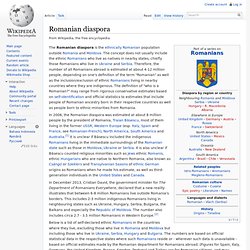
The concept does not usually include the ethnic Romanians who live as natives in nearby states, chiefly those Romanians who live in Ukraine and Serbia. Therefore, the number of all Romanians abroad is estimated at about 4-12 million people, depending on one's definition of the term "Romanian" as well as the inclusion/exclusion of ethnic Romanians living in nearby countries where they are indigenous. The definition of "who is a Romanian? " may range from rigorous conservative estimates based on self-identification and official statistics to estimates that include people of Romanian ancestry born in their respective countries as well as people born to ethnic-minorities from Romania.
Romanian language. Romanian (or Daco-Romanian; obsolete spellings Rumanian, Roumanian; autonym: română, limba română [ˈlimba roˈmɑ̃nə] ( ) ("the Romanian language") or românește (lit.

Language. Religion. Pentecostal Union of Romania. A Pentecostal church in Dej.

Pentecostals in Romania by municipality (2002 census) Pentecostals in Romania, absolute numbers (2002 census) Pentecostals in Romania by percentage (2002 census) The Pentecostal Union of Romania (Romanian: Uniunea Penticostală din România) is Romania's fourth-largest religious body and one of its eighteen officially recognised religious denominations. History[edit] Pentecostalism was introduced to Romania in 1922 by Gheorghe Bradin, who set up a thirty-member church in Păuliş, Arad County after living in the United States since before 1910; the new movement responded to a deep concern for spiritual renewal following the trauma of World War I. During the Communist period (1947-89), Pentecostalist leaders were models of cautious discretion in their relationship with the state. The church has held congresses in 1951, 1956 and every four years since 1986.
Demographic history[edit] Pentecostal Dissidents[edit] Notes[edit] References[edit] Religion in Romania. Religious denominations in Romania according to the 2011 census,[1] given as percentages of the total stable population.
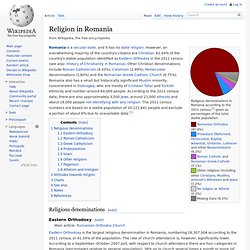
Missing Data (6.2%) Romania is a secular state, and it has no state religion. However, an overwhelming majority of the country's citizens are Christian. 81.04% of the country's stable population identified as Eastern Orthodox in the 2011 census (see also: History of Christianity in Romania). Other Christian denominations include Roman Catholicism (4.33%), Calvinism (2.99%), Pentecostal denominations (1.80%) and the Romanian Greek-Catholic Church (0.75%). Romania also has a small but historically significant Muslim minority, concentrated in Dobrogea, who are mostly of Crimean Tatar and Turkish ethnicity and number around 64,000 people. Religious denominations[edit] Eastern Orthodoxy[edit] Romanian Orthodox Church. It is the only Eastern Orthodox church using a Romance language.
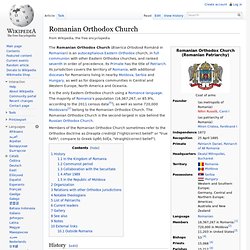
The majority of Romania's population (16,367,267, or 85.9%, according to the 2011 census data[5]), as well as some 720,000 Moldovans[2] belong to the Romanian Orthodox Church. The Romanian Orthodox Church is the second-largest in size behind the Russian Orthodox Church. Members of the Romanian Orthodox Church sometimes refer to the Orthodox doctrine as Dreapta credinţă ("right/correct belief" or "true faith"; compare to Greek ὀρθὴ δόξα, "straight/correct belief").
History[edit] Romanian Church United with Rome, Greek-Catholic. The Romanian Church United with Rome, Greek-Catholic (Romanian: Biserica Română Unită cu Roma, Greco-Catolică) is a sui iuris Eastern Catholic Church, in full union with the Roman Catholic Church.
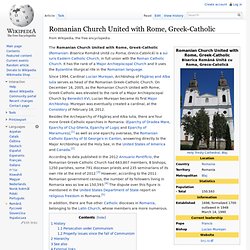
Urbanization. Education in Romania. Kindergarten is optional under the age of six.
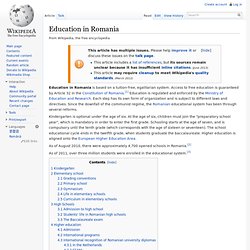
At the age of six, children must join the "preparatory school year", which is mandatory in order to enter the first grade. Schooling starts at the age of seven, and is compulsory until the tenth grade (which corresponds with the age of sixteen or seventeen). The school educational cycle ends in the twelfth grade, when students graduate the baccalaureate. Higher education is aligned onto the European Higher Education Area.
Education. Healthcare in Romania. Romania benefits of a universal healthcare system.
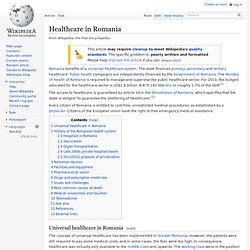
The state finances primary, secondary and tertiary healthcare. Public health campaigns are independently financed by the Government of Romania. The Ministry of Health of Romania is required to manage and supervise the public healthcare sector. For 2013, the budged allocated for the healthcare sector is US$2.6 billion (8.675.192.000 lei), or roughly 1.7% of the GDP.[1] Healthcare.